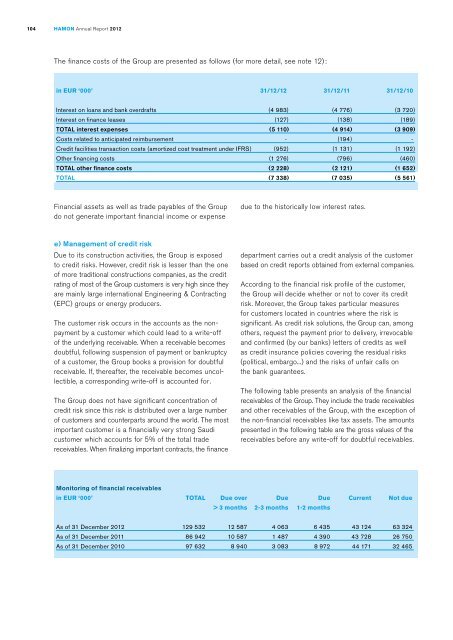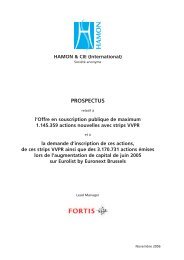Download PDF version English (3237KB) - Hamon
Download PDF version English (3237KB) - Hamon
Download PDF version English (3237KB) - Hamon
You also want an ePaper? Increase the reach of your titles
YUMPU automatically turns print PDFs into web optimized ePapers that Google loves.
104<br />
<strong>Hamon</strong> Annual Report 2012<br />
The finance costs of the Group are presented as follows (for more detail, see note 12) :<br />
in EUR ‘000’ 31/12/12 31/12/11 31/12/10<br />
Interest on loans and bank overdrafts (4 983 ) (4 776 ) (3 720 )<br />
Interest on finance leases (127) (138) (189)<br />
TOTAL interest expenses (5 110 ) (4 914 ) (3 909 )<br />
Costs related to anticipated reimbursement - (194) -<br />
Credit facilities transaction costs (amortized cost treatment under IFRS) (952) (1 131 ) (1 192 )<br />
Other financing costs (1 276 ) (796) (460)<br />
TOTAL other finance costs (2 228 ) (2 121 ) (1 652 )<br />
TOTAL (7 338 ) (7 035 ) (5 561 )<br />
Financial assets as well as trade payables of the Group<br />
do not generate important financial income or expense<br />
due to the historically low interest rates.<br />
e) Management of credit risk<br />
Due to its construction activities, the Group is exposed<br />
to credit risks. However, credit risk is lesser than the one<br />
of more traditional constructions companies, as the credit<br />
rating of most of the Group customers is very high since they<br />
are mainly large international Engineering & Contracting<br />
(EPC) groups or energy producers.<br />
The customer risk occurs in the accounts as the nonpayment<br />
by a customer which could lead to a write-off<br />
of the underlying receivable. When a receivable becomes<br />
doubtful, following suspension of payment or bankruptcy<br />
of a customer, the Group books a provision for doubtful<br />
receivable. If, thereafter, the receivable becomes uncollectible,<br />
a corresponding write-off is accounted for .<br />
The Group does not have significant concentration of<br />
credit risk since this risk is distributed over a large number<br />
of customers and counterparts around the world. The most<br />
important customer is a financially very strong Saudi<br />
customer which accounts for 5% of the total trade<br />
receivables. When finalizing important contracts, the finance<br />
department carries out a credit analysis of the customer<br />
based on credit reports obtained from external companies.<br />
According to the financial risk profile of the customer,<br />
the Group will decide whether or not to cover its credit<br />
risk. Moreover, the Group takes particular measures<br />
for customers located in countries where the risk is<br />
significant. As credit risk solutions, the Group can, among<br />
others, request the payment prior to delivery, irrevocable<br />
and confirmed (by our banks) letters of credits as well<br />
as credit insurance policies covering the residual risks<br />
(political, embargo...) and the risks of unfair calls on<br />
the bank guarantees.<br />
The following table presents an analysis of the financial<br />
receivables of the Group. They include the trade receivables<br />
and other receivables of the Group, with the exception of<br />
the non-financial receivables like tax assets. The amounts<br />
presented in the following table are the gross values of the<br />
receivables before any write-off for doubtful receivables.<br />
Monitoring of financial receivables<br />
in EUR ‘000’ TOTAL Due over Due Due Current Not due<br />
> 3 months 2-3 months 1-2 months<br />
As of 31 December 2012 129 532 12 587 4 063 6 435 43 124 63 324<br />
As of 31 December 2011 86 942 10 587 1 487 4 390 43 728 26 750<br />
As of 31 December 2010 97 632 8 940 3 083 8 972 44 171 32 465














